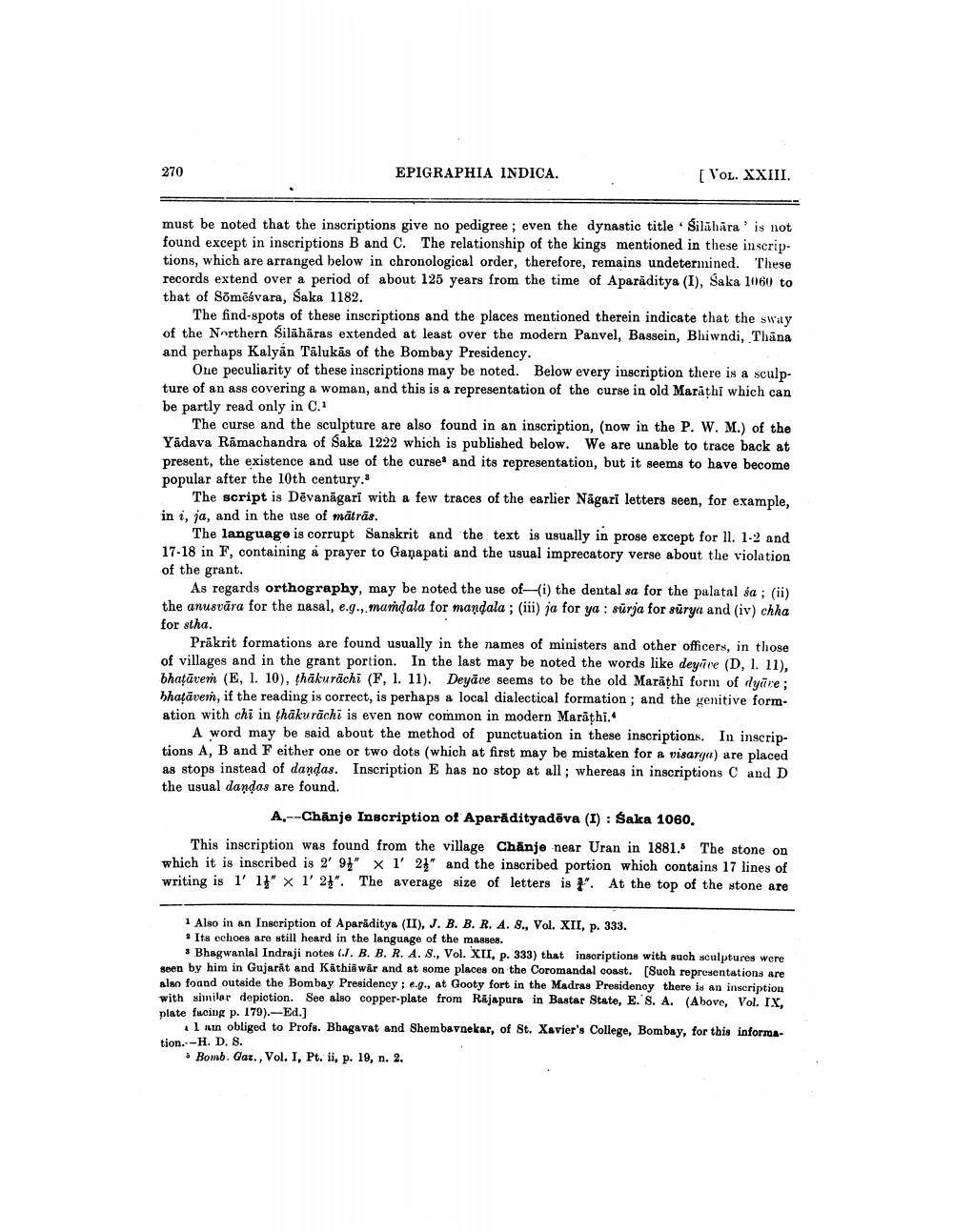________________
270
EPIGRAPHIA INDICA.
[ VOL. XXIII.
must be noted that the inscriptions give no pedigree; even the dynastic title. Silāhāra' is not found except in inscriptions B and C. The relationship of the kings mentioned in these inscriptions, which are arranged below in chronological order, therefore, remains undetermined. These records extend over a period of about 125 years from the time of Aparāditya (I), Saka 1060 to that of Sõmēsvara, Saka 1182.
The find-spots of these inscriptions and the places mentioned therein indicate that the sway of the Northern Silāhāras extended at least over the modern Panvel, Bassein, Bhiwndi, Thāna and perhaps Kalyan Talukās of the Bombay Presidency.
Oue peculiarity of these inscriptions may be noted. Below every inscription there is a sculpture of an ass covering a woman, and this is a representation of the curse in old Marathi which can be partly read only in C.
The curse and the sculpture are also found in an inscription, (now in the P. W. M.) of the Yadava Ramachandra of Saka 1222 which is published below. We are unable to trace back at present, the existence and use of the curse and its representation, but it seems to have become popular after the 10th century.
The script is Dēvanagari with a few traces of the earlier Nagari letters seen, for example, in i, ja, and in the use of mātrās.
The language is corrupt Sanskrit and the text is usually in prose except for II. 1-2 and 17-18 in F, containing a prayer to Ganapati and the usual imprecatory verse about the violation of the grant.
As regards orthography, may be noted the use of-(i) the dental sa for the palatal sa ; (ii) the anusvāra for the nasal, e.g.,mardala for mandala ; (iii) ja for ya : surja for surya and (iv) chha for stha.
Prākrit formations are found usually in the names of ministers and other officers, in those of villages and in the grant portion. In the last may be noted the words like deyire (D, 1. 11), bhatārem (E, 1. 10), thākurāchi (F, 1. 11). Deyāve seems to be the old Marăthi form of dyare; hhațāveTM, if the reading is correct, is perhaps a local dialectical formation; and the genitive formation with chi in thâkurāchi is even now common in modern Marathi..
A word may be said about the method of punctuation in these inscriptions. In inscriptions A, B and F either one or two dots (which at first may be mistaken for a visarga) are placed as stops instead of dandas. Inscription E has no stop at all; whereas in inscriptions C and D the usual dandas are found.
A.--Chânje Inscription of Aparādityadēva (I): Śaka 1060. This inscription was found from the village Chanje near Uran in 1881. The stone on which it is inscribed is 2' 9" x 1' 21" and the inscribed portion which contains 17 lines of writing is 1' 11" x 1' 21". The average size of letters is y". At the top of the stone are
1 Also in an Inscription of Aparāditya (II), J. B. B. R. A. 8., Vol. XII, p. 333. * Its echoes are still heard in the language of the masses.
Bhagwanlal Indraji notes (J. B. B. R. A. S., Vol. XII, p. 333) that inscriptions with such sculptures were seen by him in Gujarat and Kathiwar and at some places on the Coromandel coast. [Such representations are alan found outside the Bombay Presidency : e.g., at Gooty fort in the Madras Presidency there is an inscription with similar depiction. See also copper-plate from Rajapura in Bastar State, E.' S. A. (Above, Vol. IX, plate fucing p. 179).-Ed.)
lan obliged to Profs. Bhagavat and Shembavnekar, of St. Xavier's College, Bombay, for this information.-H. D. S.
• Bomb. Gaz., Vol. I, Pt. ii, p. 19, n. 2.




